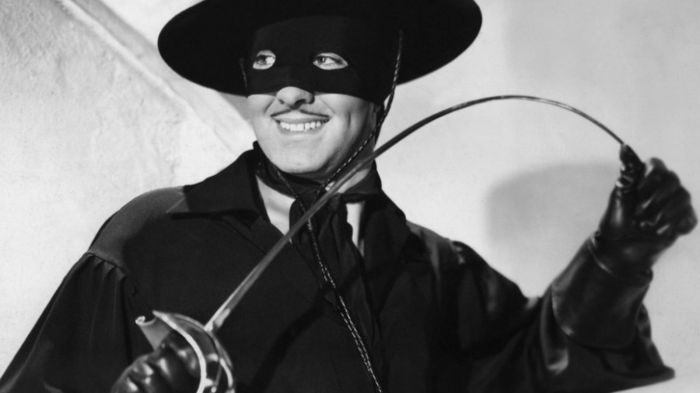Following on from my love of editing post, I’ve got a top tip for anyone about to edit their novel. This light bulb moment happened when I was reading a friend’s book. I discovered a problem that probably hits most authors who edit their own work.

Rapier sharp editing skills were Zorro’s speciality. (img src. Tyrone Power as Zorro)
So, my friend had self-published this novel and really loved it, but it just wasn’t selling. I said I’d give it a read and made editing notes in the book, so that she could take a look and make some changes, if she ever wanted to do another draft and republish.
The book was a great read. There were some things that could be changed, but nothing major in narrative terms, although, I did suggest a new cover, new title and targeting YA readers.
As I came to the last third of the book, my editing became more extensive. The first half of the book was tight. All typos and inconsistencies had been ironed out, but towards the end editing fatigue had obviously set in. And here’s how.
I bet you’re going to start editing your novel by reading it from beginning to end. You’re going to be methodical. Hone that opening page because everyone knows that’s the make or break for ensuring people read on. Then you make notes and changes and start again at chapter one. Repeat ad infinitum. The result? Your beginning is streamlined, punchy and impressive, moving seamlessly into a compelling act two. Then it all begins to fall apart because by the time you get to chapter 50 you really need a break and just want to publish the thing already.
How do you beat editing fatigue? Well, lucky you should ask because I have a strategy.
- Print off your manuscript, grab your pencil and read it from start to finish, making notes as you go. What? But that’s nothing new. Patience dear Padawan.
- Before you begin your second pass, divide your book into three equal sections. Begin your second edit from part two, which should be the middle section of your story. Read through part three and finish at the end of part one (the beginning).
- Once you’ve made your step two changes, begin reading from the start of part three of your novel, which will be the third act. You’ll finish this edit at the end of part two.
What are the benefits? By starting from a different section each time, your middle and end will get the same attention as your beginning. Otherwise you’ll be flagging by the time you get to the end, every single time you edit, letting sloppy errors get the better of you. In addition, by starting the last pass at the end of your novel and going straight through to the beginning, you’ll notice any inconsistencies in your characters, tone or theme. You may even find an opportunity for foreshadowing or leitmotif that tie the beginning and end together.
It’s also worth noting this article, which highlights Le Prix de la Page 112, a prize based on judging page 112 of a novel. Rather than falling for the opening page, which we all know is the most pampered page in any book, this literary prize has a theory that if page 112 is good, the rest of the book will be too. Page 122 is thought to be the spot where editing fatigue could set in. But armed with my trusty method, you’ll be wowing readers on every page and can laugh in the face of the page 112 challenge* – in theory.
How do you combat editing fatigue?
*Writers Anon holds no responsibility for the quality of page 112 or other pages, as a result of using the 3-step editing method.



I’m in the editing process of my novel now and noticed that I was making those same errors. It occurred to me because when I outlined my novel I separated the book into 3 parts. I realized a foreshadowing opportunity and by returning to the other section noticed the difference in my grammer errors. I am now editing in stages, but like your idea of flowing through all three sections. Great advice.
LikeLiked by 2 people
Thanks abcat1 and good luck with the editing 🙂
LikeLike
I read my book backwards. That way, I was not reading in phrases, but in words, and I found many errors. When reading in sentences, or even paragraphs, the mind automatically fills in missing pieces which will be glaring when reading backwards. The “backwards” can mean word by word or sentence by sentence. However it is done, the context is irrelevant and each moment becomes clear
.
LikeLiked by 2 people
Hi Ann – that’s a good method for that final sweep to get all the cunning typos that try to slip past unseen, but not for character and plotting type stuff.
I’m not sure I could do a whole novel that way, it must be like patting your head and rubbing your stomach 🙂
Definitely a weapon to add to the editing arsenal though.
LikeLiked by 1 person
Excellent advice Chella, many writers would do well to take note of it! Just reading a kindle published book at the moment, and it is getting weighed down by the detail about 75% in. There are some inconsistencies that need ironing out, otherwise it is a pithy and sharp book.
LikeLiked by 1 person
Thanks Mary. It’s a shame to let bad editing spoil a novel. It’s only because I read my friend’s book that I noticed this issue though, otherwise I’d probably have made the same mistake ref. editing.
LikeLiked by 1 person